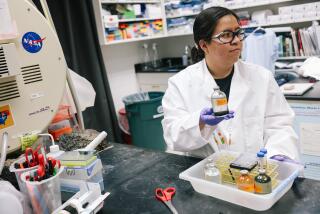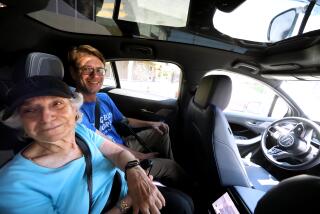Getting a Look-Sea : High Tech Will Take Students From Their Irvine Seats to the Ocean Floor
An underwater robot wiggles its tiny, boxlike body 60 feet underwater to peer over volcanic terrain, while another focuses in on feeding sharks and a third quietly eyes the coral and waits to zoom in on the ocean creaturesâ next stir.
Starting Monday and continuing for two weeks, half a million children in 20 locations across North America will sit transfixed before three huge TVs, watching live transmissions of the robotsâ underwater exploration. And this time, 15,000 students at the Beckman Center near UC Irvine will be among them.
Thanks to technology more mind-boggling than the wizardry that brings the Nintendo generation their favorite techno toys, the Orange County students will be the first on the West Coast to participate in the JASON Project and see the live undersea voyage of scientists exploring the Galapagos Islands with split-second accuracy.
âItâs a hell of a show,â said Prentice Stout, a marine educator at the University of Rhode Island Graduate School of Oceanography, who has chronicled his many trips to the Galapagos. âWithout the technology, it would not be possible, unless you do what I do: One small, old man creeping around the countryside with two projectors and a lot of slides.â
Corona del Mar High School science teacher Mike Starkweather, whose classes will be among those at Beckman Center, agreed that the program is a first-in-a-lifetime show, especially because just 60,000 visitors are allowed to stop at the Galapagos annually.
âWeâre talking about telecommunication satellites. Weâre talking about robotics. Weâre talking about the islands, which are a pristine place,â Starkweather said.
But the JASON Project almost came to a screeching halt last week, when the barge carrying all of the equipment for the show sank in the ocean about 400 miles off the Ecuadorean coast on its way to the Galapagos, falling irretrievably 9,000 feet underwater.
No one was hurt, but the freak accident cost tens of thousands of dollars in lost equipment--including the one-of-a-kind robot Jason Jr.--and threatened to end one the nationâs most-watched experiments in mixing high technology with classroom study.
Fortunately, three vessels, called MiniROVERs, can be used in Jason Jr.âs place, ensuring that show will go on. The 3-foot-long, 18-inch tall structures each weigh 110 pounds and maneuver much like Jason Jr.
âThese vehicles combined can certainly do what Jason Jr. can do,â said Shelley Lauzon, a spokeswoman for the Woods Hole Oceanographic Institute, the project headquarters.
The MiniROVER threesome will explore the ecologically rich islands, which provided Charles Darwin with a lab for his theory of evolution. They will travel from the tips of the islandsâ volcanoes through habitat-lush landscape to the depths of sea animalsâ underwater homes.
The auditorium setups at the Beckman Center and at 19 other sites give students a chance to witness a few hours of play-by-play scientific exploration, and possibly even discoveries. A select a few students will even be able to control the MiniROVER with a remote joystick at the center.
(On Saturdays, the center broadcasts will be open to the public, and on Dec. 8, there will be an all-Spanish broadcast. The project ends Dec. 14.)
After preparing for the past weeks with curricula prepared by the National Science Teachers Assn., the students will see a show that intertwines the latest technology with a study of an environmentally plush and sensitive area.
The result will be a lesson that is part robotics, telecommunications, biology, oceanography, geography, social studies--all with the instant gratification of live TV.
âPart of the excitement for youngsters is that this is pretty jazzy stuff,â said Susan Hoover, director of development at the Orange County Marine Institute in Dana Point, which is sponsoring the site at the Beckman Center.
Gene Wilhoit, executive director of the National Assn. of State Boards of Education, finds great promise in the JASON Project for setting the stage for future similar classroom ventures.
âI saw in JASON a practical application of a quality learning program of the future--but itâs here today,â Wilhoit said. âThey were using that experience to study all the distinctions we have in school, without breaking them down into artificial divisions of the math classroom, the geography room, the social studies room.â
The JASON project is the mastermind of Dr. Robert D. Ballard, a senior scientist at the Woods Hole Oceanographic Institute in Massachusetts, who after making the historic discovery of the Titanic wreckage in 1985 decided to share future expeditions with others, namely students, through state-of-the-art telecommunication hookups.
The project, and its first robot, are named after the mythical hero Jason, who in Greek lore led the Argonauts on the first successful journey across the Black Sea and home again.
With financial and technical help from public and private entities--including Turner Broadcasting, the Navy, Electronic Data Systems Corp. and the Woods Hole Institute--the JASON Project next week begins its third voyage in as many years with Star Trek-style technology that many observers say is the groundwork for the classroom of the future.
The technological maze begins its two-week run when the robots are launched from aboard the ship Nortada, which is a command post for the project. The MiniROVERs are connected with the ship through up to 250 feet of cable. The pencil-thin tethers are made up of hair-thin fiber-optic and coaxial cables that carry sights and sounds from the robotsâ cameras to the command ship.
One of the robots has an on-board computer programmed to know precisely where to explore. The other two peruse the ocean scene and are commanded to zoom in on interesting sites. Each of the robots carries a video recorder that is the eyes of the JASON Project.
Three other project sites around the 18 islands will beam images from up to 10 cameras to the shipâs command center. A scuba diver equipped with a special bubble helmet will describe what he sees in shallow waters, while a scientist on land will beam, via microwave, the images and sounds there.
From there, a TV production crew on board will siphon through the images and decides which camera is showing the most interesting sights.
The images will be broadcast to an international satellite 22,300 miles above the Equator, then beamed them down to Turnerâs Atlanta headquarters, which will then shoot the images back up to a domestic satellite that in turn will send them down to 20 sites across the country.
And all of this will transpire in about a half a second.
âItâs really some incredible technology,â said Sara Hickox, director of the office of marine programs at the Rhode Island university. âThe day of the professor getting up and giving a talk with just their booming voice is over.â
Despite all the preparation, experts are worried something could go wrong, such as the accident that sank the barge just days before the show was to begin.
âProbably the biggest nightmare at this time is the location,â said Denzel (Skip) Gleason, a former Jason pilot who helped set up the Galapagos site. âYouâre 600 miles from the mainland. There are no hardware stores down there. Once theyâre gone, theyâre committed. Thereâs no turning back. Itâs a logistical nightmare.â
But, he added, the crew is prepared even for a worse-case scenario--for example if the cables connecting the robots with the boat break or the robot springs a leak and floods. They could probably fix all that damage and get the show up and running within a day.
With that kind of preparedness, Gleason maintained that the only other threat to the show is the weather. Wind and storms over Atlanta interfered with transmissions during the JASON Projectâs first expedition, and parts of that show were lost.
With the 20 down-link sites costing $165,000 each for equipment and registration, some institute officials are looking for ways to use the technology during the 50 weeks in the year when Jason is not operating.
In Chicago, the Museum of Science and Industry may join with a local TV station to produce shows about museum exhibits that could be shown in classrooms or on cable channels.
At the University of Rhode Island, oceanographers at the graduate school want to use the system for ocean maps and charts, and the school bought an extra satellite dish to complement the system.
In Orange County, Stanley L. Cummings, executive director at the Orange County Marine Institute, is trying to encourage other down-link site operators to run programs that they could share.
For example, the institute could produce programs about marine life off the West Coast, say the migration of whales, which could be broadcast to other down-link sites such as the one at the Chicago museum.
Likewise, those institutes and museums could send their productions to Orange County, where school classes and the public could watch the shows.
âThis was already on the drawing boards. The goals are so well intertwined,â said Cummings, whose institute is in the midst of fund raising for an expansion that will include a theater specifically for annual JASON Project broadcasts.
âTo me, itâs a real natural extension; it just makes everything we do bigger.â
How JASON Will Transmit to O.C.
The JASON Project, named after one of Dr. Robert D. Ballardâs deep-sea robots that helped find the sunken Titanic in 1985, will begin a two-week expedition to the Galapagos Islands Monday. It will broadcast live transmissions to half a million students nationwide, 15,000 of them at the West Coastâs first down-link spite sponsored by the Orange County Marine Institute at the Beckman Center.
Using microwave communications, land scientist transmit sights and sounds of the islandsâ rich wildlife to the ship command center.
A scientist in shallow waters and a deeper positioned robot, MiniROVER, beam image and voice transmissions through cables to ship center. Information is sent to an international satellite above Ecuador, down to Turner Broadcasting System headquarters in Atlanta, up to a domestic satellite, and back down to 20 locations nationwide, including the new site in Irvine.
More to Read
Sign up for Essential California
The most important California stories and recommendations in your inbox every morning.
You may occasionally receive promotional content from the Los Angeles Times.











